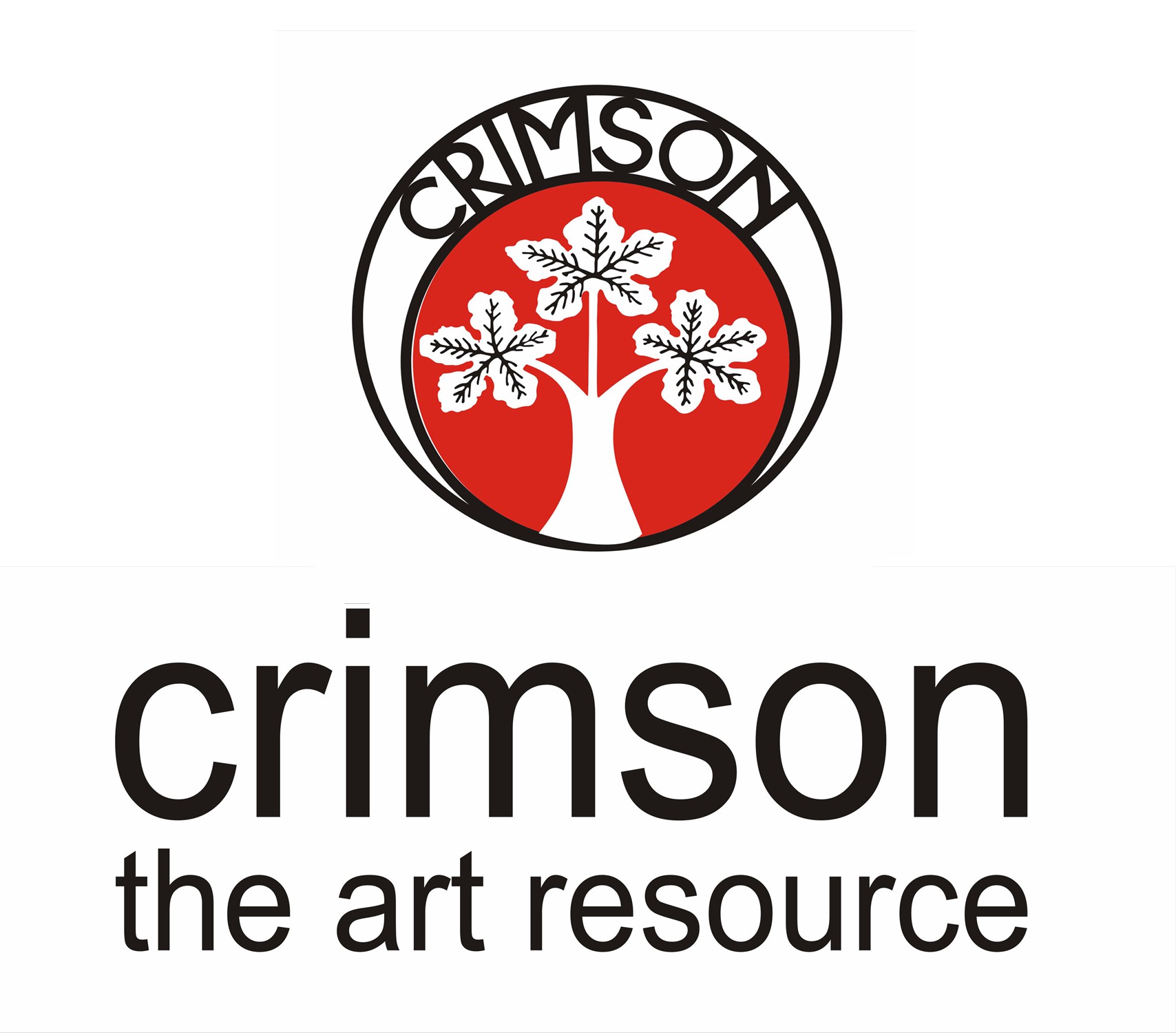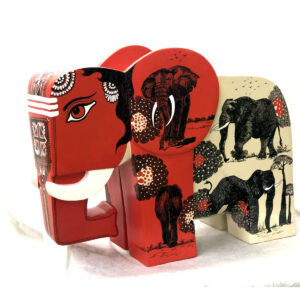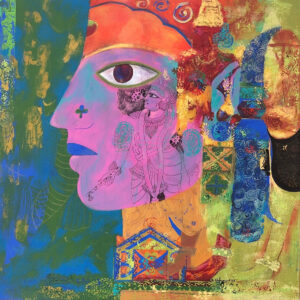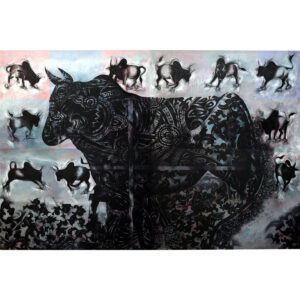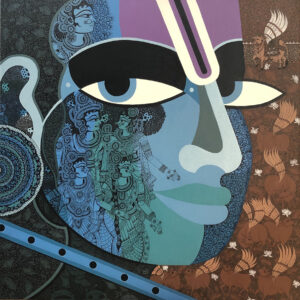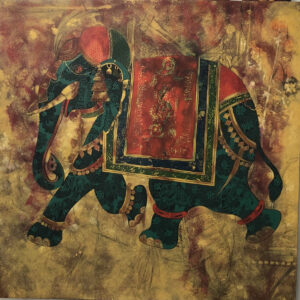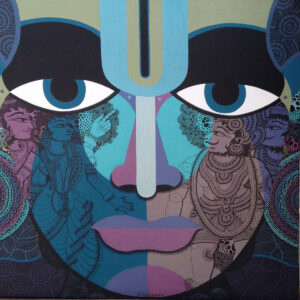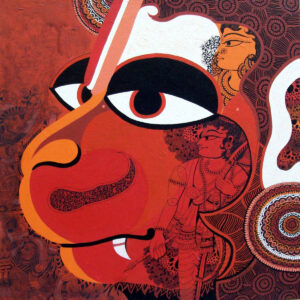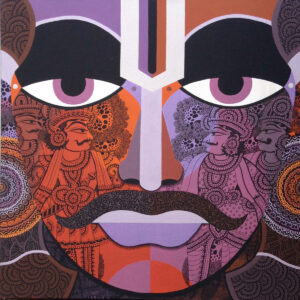Bolgum Nagesh Goud was born in 1965. He did his GRADE “ A “ Maharastra Art Certificate 1987 with Distinction. He graduated with a B.F.A with University Gold Medal from College of Fine Arts, Jawaharlal Nehru Technology University, Hyderabad in 1993. He has several solo shows to his credit notably “ A PERFECT TALE “ 2012 SOLO at TULIKA ARTS GALLERY , MUMBAI ; TRAVELLING SHOW – “ A PERFECT TALE “ II – in 2013 KRISALA ARTS BANGALORE; “KHAHANI “ A PERFECT TALE-3 : 20123-2014 at Shrishti Art Gallery, Hyderabad; “ KATHA “ Tales of reviving an art form – AT TULIKA ARTS Gallery MUMBAI 201-2015. Curation : “ Gaja” The Elephant Sculpture show 2020-at Hyderabad State Art Gallery, Hyderabad. He was awarded 2010 – “ AWARD “ by Hyderabad Art Society- All india Art exhibition 2010
The subject matter of Nagesh’s artwork is inspired by traditional leather puppetry. The works rejuvenate the visual interpretations of stories picked up from the epics, Mahabharata and Ramayana. The ever so popular characters from the epics come to life in a new light and stance in his works. He creates an exquisite stage for his ‘Nayak’ and ‘nayika’ so that they can exemplify their strengths and spirits at the very best.
The known episodes and anecdotes from Mahabharata and Ramayana unfold to the viewers gradually in the paintings. He aptly arranges a huge portrait of one’ nayak’ in the centre of the composition and then creatively adorns him as well his surrounding sections with excerpts picked up from the characters contribution in taking story line of the popular epic ahead. The linear rhythm of the ‘thollu bommalata ‘gets recreated in his paintings and sculptures. The “Line” intricate and lyrical, bold and sensitive carves out the silhouettes of the figures and then turns inside the form to define the details in a specifically aesthetic and creative manner. The features of the characters are sharp, defined and finely chiseled. The huge, soulful, almond shaped eyes are the most prominent feature of the portraits. The line boldly yet lyrically runs over the coloured areas and while doing so it connects the different colour planes into a single entity, weaving them together with intricate patterns, floral clusters, motifs and suggestive jewelry.
-
- Out of Stock
- Abstract Art, Artists, Exhibition, Figurative Art, Gaja, Nagesh Goud, Sculpture
Nagesh Goud
- ₹200,000
- Title: Gaja Medium: Polyester Resin Fibreglass Painted Dimensions: 17 X 13 X 6 inches (L x Hx W) Weight: 3 K.g
- Read more
-
-
- Out of Stock
- Artists, Exhibition, Figurative Art, Gaja, Nagesh Goud, Paintings
Nagesh Goud
- ₹135,000
- Title: Radhakrishna Medium: Metallic Acrylic and Ink on Canvas Dimensions: 30 X 30 inches (H x W)
- Read more
-
-
- Out of Stock
- Artists, Drawings, Exhibition, Figurative Art, Gaja, Large Format Art, Nagesh Goud, Paintings
Nagesh Goud
- ₹1,312,500
- Title: Jallikattu Medium: Charcoal and Acrylic on Canvas Dimensions: 96 X 144 inches (H x W)
- Read more
-
-
- Out of Stock
- Artists, Exhibition, Figurative Art, Gaja, Nagesh Goud, Paintings
Nagesh Goud
- ₹172,000
- Title: Vrindavan Krishna Medium: Metallic Acrylic and Ink on Canvas Dimensions: 36 X 36 inches (H x W)
- Read more
-
-
- Out of Stock
- Artists, Exhibition, Figurative Art, Gaja, Nagesh Goud, Paintings
Nagesh Goud
- ₹135,000
- Title: My Elephant Sita Medium: Metallic Acrylic and Ink on Canvas Dimensions: 30 X 30 inches (H x W)
- Read more
-
-
- Artists, Figurative Paintings, Nagesh Goud, Paintings, Paintings on Canvas
Nagesh Goud
- Title: Lord Hanuman Medium: Mixed Media on Canvas Dimensions: 24 X 24 inches
- Request Price
